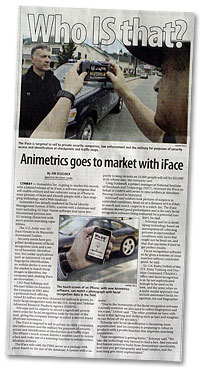Recent News
Animetrics takes iFace to market
Conway, NH - September 22nd, 2008
Animetrics Inc. is going to market this month with a limited release of its iFace, a software program that will enable military and law enforcers using an iPhone to snap pictures of faces and identify people with a face-mapping technology and a Web database. Animetrics has already marketed its Facial Identity Management System (FIMS), a server with a database and tools including 3D Face Viewer software that turns two-dimensional pictures into 3D rotating characters with more precise matching capabilities.
Animetrics has already marketed its Facial Identity Management System (FIMS), a server with a database and tools including 3D Face Viewer software that turns two-dimensional pictures into 3D rotating characters with more precise matching capabilities.The U.S. Army uses 3D Face Viewer in its Biometric Automated Toolset.
Security needs have propelled development of facial recognition tools and a sector of biometric identification, but unlike applications such as automated iris and fingerprint identification, no mobile device is now on the market to match facial images to identities, the company said, making iFace an innovation.
CEO Paul Schuepp and Michael Miller co-founded the company in 2003 after a preferred stock offering raised $2 million and they obtained $3 million in grants, to build facial recognition tools for the U.S. Army and Defense Advanced Research Products Agency (DARPA).
Schuepp said he expects to secure a significant government order for facial recognition tools by the end of the year, giving the company leverage to solicit a second round of private investment.
The iFace is targeted to sell to private security companies, law enforcement and the military for purposes of security access and identification at checkpoints and traffic stops. The iPhone's touch-screen interface enables users to isolate a face and make use of a zooming function to enhance identification abilities.
The iFace sells with the FIMS server as a package with prices based on the size of the database. A system with a capacity to keep records on 10,000 people will sell for $25,000 at its release date, the company said.
Craig Schlenoff, a project manager at National Institute of Standards and Technology (NIST), reviewed the iFace on behalf of DARPA with seven to nine soldiers at Aberdeen Proving Ground in Maryland.
Schlenoff said soldiers took pictures of suspects in controlled conditions, head-on at a distance of 6 to 8 feet, to search and match suspects to a watch-list. The iFace software showed good performance and is the only facial recognition software being evaluated for a potential contract, he said.
Schuepp said he is developing technology based on assumptions of collecting pictures in uncontrolled conditions with faces that might not be head-on, and that that can make it hard to get perfect results.
Facial recognition software so far gives a number of close matches without conclusive proof, he said.
Lt. Col. Kathy DeBolt of the U.S. Army Training and Doctrine Command (TRADOC) office said facial recognition is so far not sophisticated enough to be used on its own, and the army relies on a multi-modal approach that include automated facial recognition, iris and fingerprint scans.
"Due to the immaturity of the facial recognition software currently available we also need to collect fingerprints and iris scans," DeBolt said. "The other problem we have with facial is that lighting and clothing such as hats and sunglasses can throw off the accuracy."
Schuepp said facial identification is becoming more sophisticated and his company is preparing to refine its products with a profile function that improves matching capabilities.
"Face recognition is getting better," Schuepp said. "We take the technology way beyond to find a face, find eyes and find feature points to build three dimensional coordinates, and now you get topography and head rotation, and the matching gets more sophisticated."
About Animetrics
Animetrics Inc., headquartered in Conway, N.H., is a leading developer of 3D imaging for facial biometric systems. The Animetrics90 product family is based on the company's core algorithms comprised of five patent-pending, 2D-to-3D face-creation technologies, allowing for pose and lighting invariant face recognition across a broad range of operating conditions. This breakthrough technology forms the basis for Animetrics next-generation three-dimensional facial recognition applications. Animetrics is driving market acceptance of facial recognition biometrics in government, homeland security and law enforcement applications. For more information visit http://www.animetrics.com